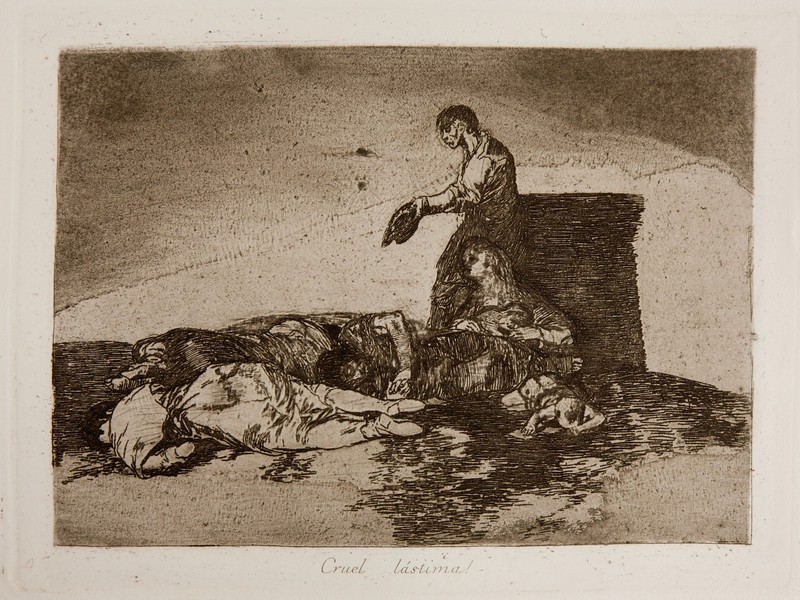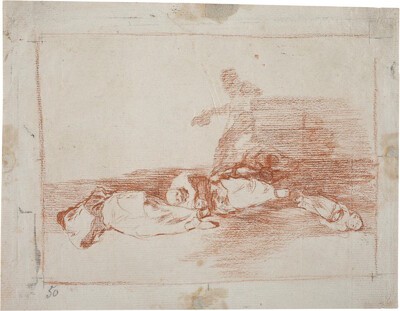- Cronología
- Ca. 1812 - 1815
- Dimensiones
- 151 x 208 mm
- Técnica y soporte
- Aguafuerte, buril, lavis bruñido y bruñidor
- Reconocimiento de la autoría de Goya
- Undisputed work
- Ficha: realización/revisión
- 15 Dec 2010 / 24 May 2023
- Inventario
- 225
See Sad presentiments of what must come to pass.
The title was handwritten on the print by Goya in the first and only series that is known to have been printed at the time the works were created, which the artist gave to his friend Agustín Ceán Bermúdez. Therefore, the title was etched into the plate at a later date and left unchanged as of the first edition of the Disasters of War printed by the San Fernando Royal Academy of Fine Arts in Madrid in 1863, after the printing of the series in the possession of Ceán Bermúdez.
There is a surviving preparatory drawing for this print which is housed in the Prado Museum.
This print begins the second part of the Disasters of War series, in which Goya deals in depth with the subject of hunger as one of the principal consequences of war. The most difficult moments of the war came with the famine of 1811-12. Both the abandonment of lands and the increased population due to the presence of the French army meant that the wheat harvest was very scarce, and it was necessary to resort to making flour from other grains or pulses in order to make bread. The introduction of alternative ingredients into the population's diet and the adulteration of foodstuffs led to significant health problems in the general public. Consequently, in July 1812 bread makers were informed that all bakers employing harmful substances in their products would be subject to harsh punishment.
This image shows a family in the middle of a desolate landscape, surrounded by dead bodies. The man is shown standing side-on, holding out a hat in his hands in the vain hope of receiving alms. The woman sat next to him is holding a child in her arms. Among the different corpses strewn around the family is the striking figure of a dead child.
Goya has created an almost spectral sky in aquatint which looms over the figures in this print but does not protect them. The dead bodies and the three still living figures in the print have been executed in decisively etched strokes. The face of the begging man is emaciated, with protruding jaw, cheekbones and eye sockets, and he wears a lost look. These are the victims of the famine, from which they were unable to defend themselves and which will probably end their lives as it has those of the others around them.
La plancha se conserva en la Calcografía Nacional (cat. 299).
-
Goya. Drawings, Etchings and LithographsGoya. DrawingsLondon1954from June 12th to July 25th 1954pp. 8-10, cat. 63
-
Francisco de Goya: Maleri, Tegning, GrafikkNasjonalgallerietOslo1996from 10th to April 14th 1996cat. 143
-
Francisco de GoyaMuseo d'Arte ModernaLugano1996exhibition celebrated from September 22nd to November 17th.cat. 48
-
Francisco Goya. Sein leben im spiegel der graphik. Fuendetodos 1746-1828 Bordeaux. 1746-1996Galerie KornfeldBern1996from November 21st 1996 to January 1997cat. 132
-
Francisco Goya. Capricci, follie e disastri della guerraSan Donato Milanese2000Opere grafiche della Fondazione Antonio Mazzottacat. 128
-
Goya. Opera graficaPinacoteca del Castello di San GiorgioLegnano2006exhibition celebrated from December 16th 2006 to April 1st 2007p. 75
-
Goya et la modernitéPinacothèque de ParisParís2013from October 11st 2013 to March 16th 2014cat. 87
-
2022
-
Goya, grabadorMadridBlass S.A.1918cat. 150
-
Goya engravings and lithographs, vol. I y II.OxfordBruno Cassirer1964cat. 168
-
Vie et ouvre de Francisco de GoyaParísOffice du livre1970cat. 1070
-
Catálogo de las estampas de Goya en la Biblioteca NacionalMadridMinisterio de Educación y Cultura, Biblioteca Nacional1996cat. 257
-
ParísPinacoteca de París2013p. 143
-
Goya. In the Norton Simon MuseumPasadenaNorton Simon Museum2016pp. 114-151
-
Museo de Bellas Artes de Badajoz y Diputación de Badajoz2022p. 69

